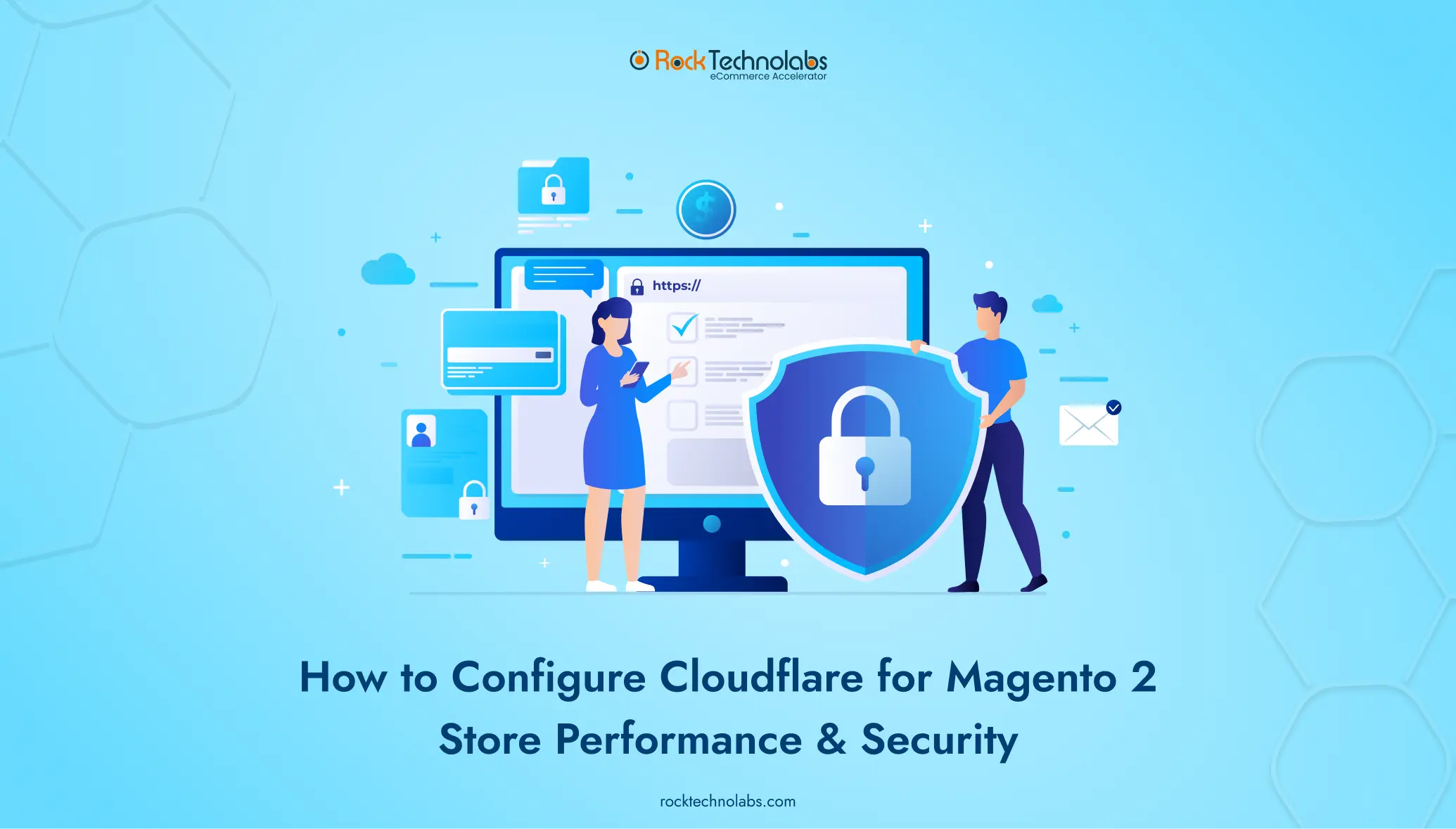How to Configure Cloudflare for Magento 2 Store Performance & Security

Let’s take an example that might have happened with you or could be in your business journey. It’s a Christmas season and thousand and thousand of customers, are landing on your website to purchase products for themselves and their loved ones as they want to grab your exclusive deals, but as traffic spikes, your site slows down, pages take forever to load, and some customers abandon their carts out of frustration, which is creating a panic in you, and you are thinking what is happening.
Even your technical team is trying to handle it but it’s taking time. Worse, a sudden security threat lurks in the background, ready to disrupt everything. This is the nightwear of almost every Magento merchant because their business sale depends on it.
But we don’t want you to face this situation, and fortunately enough, there’s a solution that will establish your store faster, safer, and more reliable source to visit by your customers Cloudflare, which offers speed optimization, advanced security, and seamless scalability to help Magento 2 stores deliver a smooth shopping experience even during the most demanding times.
Why Use Cloudflare for Magento 2?
1. Global Content Delivery Network (CDN)
One of the primary reasons Magento merchants and developers have begun using Cloudflare is its comprehensive CDN, which has data centers strategically distributed across the globe that help Magento stores in delivering content from the server geographically closest to them, significantly reducing latency, thus irrespective of how big your site is, and where you customers are located, Cloudflare CDN is going to ensure that all your pages load quickly.
Note – Fasted page loading not only improves the customer satisfaction rate but also assists you in getting a higher conversion rate because cached copies of static content such as product images, JavaScript files, and style sheets, Cloudflare reduces the load on your hosting server and provides a seamless shopping experience.
2. Improved Performance
Whether is it about user experience, conversion rate, bounce rate, or ultimately in the long run your business success performance optimization can’t be neglected at Cloudflare offer enough value when it comes to increasing performance, as Cloudflare intelligently optimizes content delivery means, Images, videos, and other static assets are cached at the edge, meaning they’re delivered faster without repeatedly hitting the origin server.
Besides this, it reduces file sizes, speeds up content delivery, and minimizes bandwidth usage also automatically by removing unnecessary characters and spaces from CSS, JavaScript, and HTML files without altering functionality.
Read more – How Hyva Improve Magento Store Performance
3. Enhanced Security
A security crisis could greatly affect the performance of your store, as well as your and customers’ data. Cloudflare’s suite of security features helps safeguard Magento 2 stores by automatically detecting and mitigating distributed denial-of-service attacks, plus it encrypts data between your customers and your server, therefore securing information like login credentials and payment details.
Furthermore, another reason for choosing Cloudflare is that it blocks malicious activities such as cross-site scripting, SQL injections, and checkout fraud bots by identifying harmful bots, and allowing good bots to function properly, like search engine crawlers.
4. Minification of Code
If you want to improve or increase the performance, accessibility, speed, and overall conversion rate of your Magento store, then relying on minification of code is a good option that has been used for years for websites (being a very reliable method) to reduce load times and bandwidth usage on websites, which can be done by removing JS, CSS, and HTML files.
Moreover, this process in Cloudflare also assists in lowering bandwidth consumption, which can be particularly beneficial for mobile users where there are connection issues, or mostly slower connections, which will give faster-loading pages, improve user experience, and encourage visitors to stay longer, browse more, and ultimately convert better.
5. Load Balancing for High Availability
Why Cloudflare Load Balancing feature is important for your Magento store – when endpoints is not working properly it assist in distributing traffic across your endpoints, keep its eyes on endpoints at configurable intervals and across multiple data centers to look for specific status codes, response text, and timeouts, you can choose distribution of requests based on visitor’s region, and review comprehensive analytics to evaluate traffic flow as well as review changes in pools.
With such a number of benefits at hand for Magento 2 stores, this type of approach for your Magento store provides consistent performance and reliability, even during unexpected traffic surges, which is especially necessary for Magento stores running promotions, flash sales, or experiencing seasonal spikes.
6. Enhanced SEO Through Faster Performance
We don’t need to explain why uninterrupted SEO activities are important for your Magento store; anything, whether it’s technical like speed or non-technical like content, can affect the performance of your store and result in your website crumbling down in SERP results. The role that Cloudflare plays is that it directly improves faster-loading product pages and category listings, so your site’s performance remains consistent for national as well as international visitors, and later on, this same thing results in better visibility, increased organic traffic, and more sales opportunities.
How You Can Integrate Cloudflare Into Your Magento Store – Step-by-Step Process
What Are The Prerequisites You Must Look For Setting Up Cloudflare for Magento 2
- Cloudflare Account: Sign up for a Cloudflare account if you don’t already have one.
- Authorized Domain: Add and verify the domain you want to connect to Cloudflare.
- Magento Store Ready: Ensure your Magento 2 store is fully set up and running.
You’ll also need to own a domain to use Cloudflare.
- If you don’t have one yet, register a domain through any domain registrar.
- To make this process more simple, and less complex, you can directly visit the Cloudflare site, where you can buy your domain directly from Cloudflare Registrar, which automatically uses Cloudflare as your authoritative DNS.
Now let’s move further with all the steps required to set up Cloudflare with your Magento store.
1. Create a Cloudflare Account
- Sign Up: Go to Cloudflare’s website and create a free account if you don’t already have one.
- Add Your Website: After logging in, click “Add a Site” and enter your domain name. Then click “Add Site” to continue.
2. Set Up DNS
- Check DNS Records: Cloudflare will scan and import your existing DNS records automatically. Review them to ensure they’re correct, and add any missing ones if needed.
- Update Nameservers: Cloudflare gives you new nameservers. Log into your domain registrar (where you bought your domain) and replace your current nameservers with these. It may take up to 24 hours for changes to take effect.
3. Install the Cloudflare Extension in Magento 2
Install via Composer: Run this command in your Magento 2 root directory:
bash
CopyEdit
composer require cloudflare/magento2
Activate the Extension: Enable it with:
bash
CopyEdit
php bin/magento module:enable Cloudflare_Magento2
php bin/magento setup:upgrade
- Configure the Extension:
- Log in to your Magento Admin Panel.
- Go to Stores > Configuration > Cloudflare.
- Enter your Cloudflare API Key and email.
- Adjust other settings (like cache time and CDN preferences) based on your needs.
4. Adjust Cloudflare Settings
- Caching: In the Cloudflare dashboard, choose how you want to cache static files (images, CSS, JS). Set page rules for specific sections if needed.
- Enable SSL: Under SSL/TLS, turn on SSL to encrypt all traffic. Cloudflare provides a free SSL certificate.
- Firewall Rules: Add firewall rules to block bad traffic and protect your store from common attacks.
5. Test and Monitor
After completion of all the settings in regards to Cloudflare to your Magento store, go and check the performance by leveraging tools like Google PageSpeed Insights or GTmetrix to confirm that Cloudflare is improving speed and caching content properly.
In addition to this, you should also look at how Cloudflare Analytics is working because it will help you in tracking performance, visitor data, and any security threats.
Conclusion
It doesn’t matter whether you are a small business or large, at the heart of every business when it’s online depends on the experience they are offering to its customers, and this what Cloudflare assist in doing if you are approaching its integration, and features with a proper strategy with the help of Magento developers, that ultimately builds a strong foundation for performance, security, and growth. With features like CDN, load balancing, code minification, and advanced security, Cloudflare ensures your store runs smoothly for customers everywhere while keeping threats at bay.







